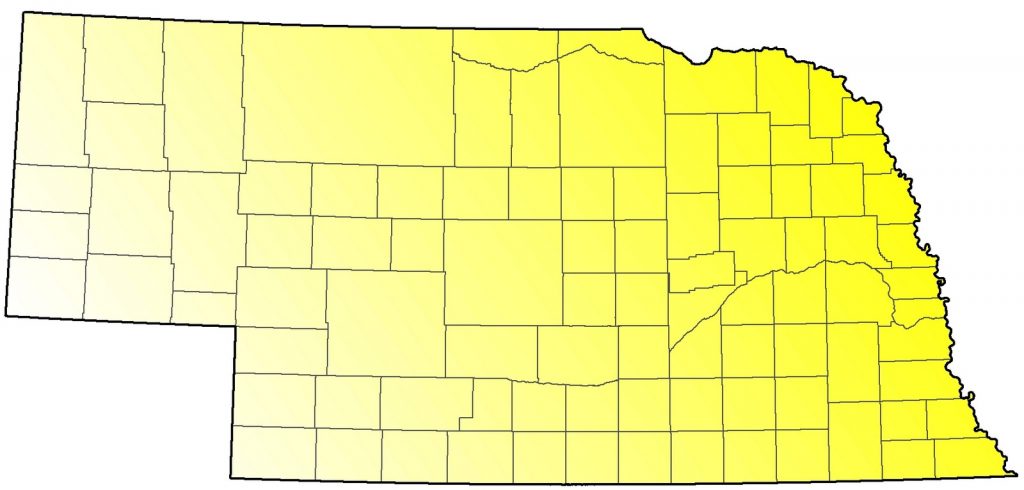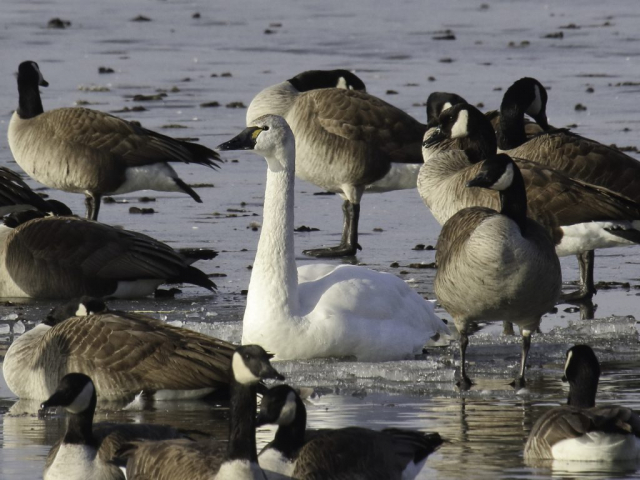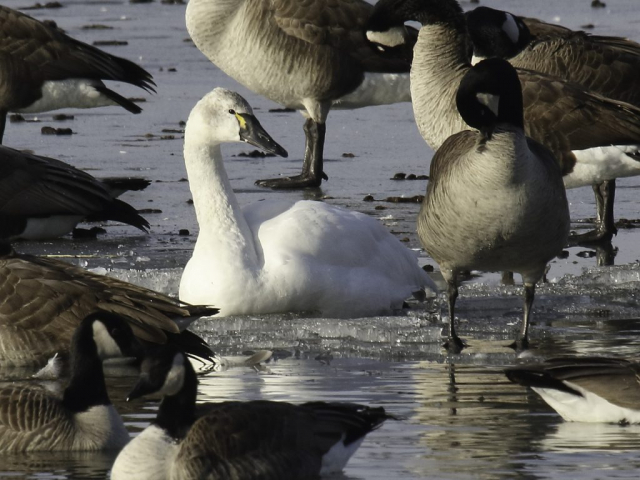Cygnus columbianus columbianus
Status: Increasing. Rare regular spring and fall migrant statewide. Rare to locally uncommon regular winter visitor statewide.

Documentation: Specimen: HMM 2822, 27 Oct 1917 Doniphan, Hall Co.
Taxonomy: There are two subspecies, columbianus and bewickii, the latter Eurasian in distribution (AviList 2025). The subspecies were formerly treated as separate species, Whistling Swan (columbianus) of North America, and Bewick’s Swan (bewickii) of Eurasia (Limpert et al 2020).
Birds from eastern Russia are sometimes separated as the subspecies jankowskii, but differences from bewickii and columbianus are minimal (Limpert et al 2020).
Nebraska birds are columbianus.
Spring: Feb 18, 18, 19 <<<>>> Mar 28, 28, 30
One of the early dates above is of a migrating flock of 15 over Nemaha/Richardson Cos 18 Feb 2013.
Later dates are 3 Apr 2021 Lake Ogallala, Keith Co, 4 Apr 2017 Seward Co, and 19-28 Apr 2021 Platte Co (photo, eBird.org).
There are a few older records of later dates; it is likely that these were indeed of Tundra Swans, as Trumpeter Swans were rare on the Great Plains until the 1970s. These are: 15 Apr 1975 Clay Co (Jorgensen 2012), 27 Apr-14 May 1952 Platte Co (Kinch 1968), 30 Apr-3 May 1936 Clay Co (Kinch 1968, Jorgensen 2012), 5 May 1947 Brown Co (Youngworth 1955), 7 May 1930, 1931, or 1932 (15) Sheridan Co (Rosche 1982).
Peak movement is in mid-Mar. The traditional migration pathway of this species extends from the Atlantic Coast to High Arctic breeding grounds, generally coming no closer to Nebraska than Minnesota and northeast South Dakota.
After several winter reports 2024-2025, no Tundra Swans were reported Mar-May 2025, suggesting the birds wintering with Trumpeter Swan flocks moved north with them prior to Mar, and no true migrants were detected.
- High counts: 17 in Douglas Co 17 Mar 2002, 15 in Sheridan Co spring 1930, 1931, or 1932 (Rosche 1982), 15 over Nemaha Co 18 Feb 2013, and 15 in northwest Burt Co 5 Mar 2020.
Fall: Nov 1, 2, 3 <<<>>> winter
Earlier dates are 29 Sep 1950 Columbus, Platte Co (UNSM ZM10989), and 8 Oct 1983 Sarpy Co (Phil Swanson, personal communication).
Later dates of presumed migrants are 30 Nov 2020 (4) Cherry Co, 1 Dec 2022 (11) Lake Ogallala Diversion Dam, Keith Co, 1 Dec 2022 Columbus, Platte Co, 2-6 Dec 2019 Dakota Co, and 3 Dec 2020 (2) Gavin’s Point Dam, Knox Co. Later dates are included in Winter, below.
A good showing in fall 2022 was the eight records involving at least 16 individuals in six counties 13-27 Nov, west to Lincoln Co. Similarly, in fall 2023 there were reports 4-30 Nov from five eastern locations, west to Fillmore Co, of 12 individuals in all. In 2024, 23 in all were reported at four locations statewide 21-30 Nov.
- High counts: 16 in Douglas Co 23 Dec 2023, 14 at Box Butte Reservoir, Dawes Co 22-23 Nov 2024, and 8 in Douglas Co 17 Dec 2021.
Winter: Along with the large increase in numbers of Trumpeter Swans in recent years, this species, formerly only a rare spring and fall migrant in Mar and Nov, is increasingly found wintering in low numbers with Trumpeter Swan flocks. Prior to winter 2013-2014 there were only 10 winter reports, notably two in Douglas Co 23 Dec 1998-7 Feb 1999 (Jorgensen 2001), 1 Jan 1938 Logan Co (Rapp 1950), up to three immatures below Keystone Dam, Lake Ogallala, Keith Co 14-15 Jan and 7-13 Feb 1998 (Brogie 1999), and 5 Feb-5 Mar 1972 Lancaster Co.
Beginning in winter 2013-2014, there were reports each winter, notably at Carter Lake, Douglas Co, where there were reports 2013-2014 through 2016-2017 in the period 3 Jan-26 Feb with a maximum of six birds. As of spring 2021, there were about 23 reports in all statewide 4 Dec-17 Feb; best count was up to seven 26 Dec 2014-1 Feb 2015 at Lake McConaughy, Keith Co. A notable increase in documented reports occurred in winter 2021-2022; some 24 individuals were reported from eight locations in Lincoln, Platte, Washington, Douglas, and Sarpy Cos, with best count eight near Valley, Douglas Co 17 Dec 2021. In winter 2022-2023 up to six birds were reported 10 Dec-1 Feb from four locations in Washington, Douglas, Sarpy, and Lincoln Cos, and in winter 2023-2024 a total of 26 were reported from seven locations. Numbers continued to increase in winter 2024-2025; about 37 were reported at about 10 locations.
Images
Abbreviations
HMM: Hastings Municipal Museum
UNSM: University of Nebraska State Museum
Literature Cited
AviList Core Team, 2025. AviList: The Global Avian Checklist, v2025. https://doi.org/10.2173/avilist.v2025.
Brogie, M.A. 1999. 1998 (Tenth) Report of the NOU Records Committee. NBR 67:141-152.
Jorgensen, J.G. 2001. 1999 (Eleventh) Report of the NOU Records Committee. NBR 69: 85-91.
Jorgensen, J.G. 2012. Birds of the Rainwater Basin, Nebraska. Nebraska Game and Parks Commission, Lincoln, Nebraska, USA.
Kinch, C. 1968. Swans. NBR 36: 16-19.
Limpert, R.J., S.L. Earnst, C. Carboneras, and G.M. Kirwan. 2020. Tundra Swan (Cygnus columbianus), version 1.0. In Birds of the World (S. M. Billerman, Editor). Cornell Lab of Ornithology, Ithaca, NY, USA. https://doi.org/10.2173/bow.tunswa.01.
Rapp, W.F. Jr. 1950. Twenty-five Year Summary of Bird Migration in Nebraska. NBR 18: 23-24.
Rosche, R.C. 1994. Birds of the Lake McConaughy area and the North Platte River valley, Nebraska. Published by the author, Chadron, Nebraska, USA.
Youngworth, W. 1955. Some birds of the Quicourt Valley. NBR 23: 29-34.
Recommended Citation
Silcock, W.R., and J.G. Jorgensen. 2025. Tundra Swan (Cygnus columbianus). In Birds of Nebraska — Online. www.BirdsofNebraska.org
Birds of Nebraska – Online
Updated 28 Jul 2025


